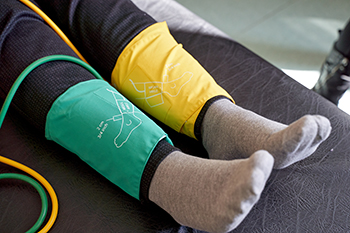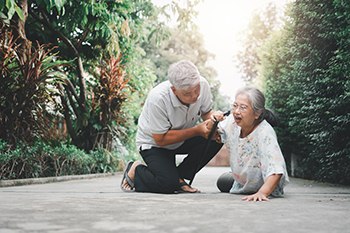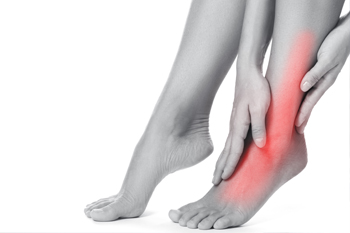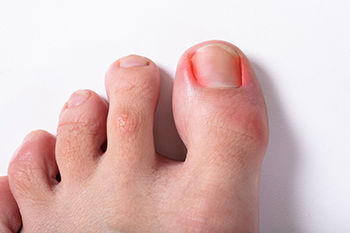Items filtered by date: April 2024
Foot Struggles with Peripheral Artery Disease

Peripheral artery disease, or PAD, is a condition characterized by narrowing or blockage of the arteries, typically in the legs, due to the buildup of fatty deposits. This restricts blood flow to the limbs, affecting the feet and causing various symptoms. Those at risk include smokers, diabetic patients, individuals with high blood pressure or cholesterol, and those with a family history of cardiovascular disease. Symptoms may include leg pain, cramping, numbness, weakness, or coldness in the feet and legs, especially during physical activity. However, some people with PAD may not experience any symptoms, a condition known as asymptomatic PAD. A podiatrist evaluates PAD through a comprehensive consultation, which may include assessing symptoms, and medical history, and performing tests like ankle-brachial index measurements or Doppler ultrasound to determine blood flow. Treatment focuses on managing symptoms, improving circulation, and reducing the risk of complications through lifestyle changes, medications, or surgical interventions. If you suffer from foot symptoms of PAD, it is suggested that you schedule an appointment with a podiatrist for care.
Peripheral artery disease can pose a serious risk to your health. It can increase the risk of stroke and heart attack. If you have symptoms of peripheral artery disease, consult with Dr. Barbara Davis from Gilbert Podiatry. Our doctor will assess your condition and provide you with quality foot and ankle treatment.
Peripheral artery disease (PAD) is when arteries are constricted due to plaque (fatty deposits) build-up. This results in less blood flow to the legs and other extremities. The main cause of PAD is atherosclerosis, in which plaque builds up in the arteries.
Symptoms
Symptoms of PAD include:
- Claudication (leg pain from walking)
- Numbness in legs
- Decrease in growth of leg hair and toenails
- Paleness of the skin
- Erectile dysfunction
- Sores and wounds on legs and feet that won’t heal
- Coldness in one leg
It is important to note that a majority of individuals never show any symptoms of PAD.
Diagnosis
While PAD occurs in the legs and arteries, Podiatrists can diagnose PAD. Podiatrists utilize a test called an ankle-brachial index (ABI). An ABI test compares blood pressure in your arm to you ankle to see if any abnormality occurs. Ultrasound and imaging devices may also be used.
Treatment
Fortunately, lifestyle changes such as maintaining a healthy diet, exercising, managing cholesterol and blood sugar levels, and quitting smoking, can all treat PAD. Medications that prevent clots from occurring can be prescribed. Finally, in some cases, surgery may be recommended.
If you have any questions, please feel free to contact our office located in Gilbert, PA . We offer the newest diagnostic and treatment technologies for all your foot care needs.
Safeguarding Your Feet and Home

Preventing slips, trips, and falls is essential for avoiding injuries, including those that are foot-related. Falls account for nearly one-third of non-fatal injuries in the United States, highlighting the importance of proactive measures to mitigate risks. In the home, maintaining good housekeeping practices and promptly addressing spills or leaks can significantly reduce the likelihood of accidents. Proper maintenance of flooring and walking surfaces is also essential to prevent slips and trips. Differentiating between slip-resistant footwear for wet or slippery conditions and shoes with proper traction for outdoor activities can further enhance safety. By prioritizing preventive measures, individuals can safeguard against falls and protect their overall well-being. If you have sustained a foot-related injury from a slip, trip, or fall, it is suggested that you schedule an appointment with a podiatrist for treatment. This medical professional can provide valuable guidance on footwear selection and foot care practices to improve stability and reduce the risk of falls, especially for individuals with underlying foot conditions or mobility issues.
Preventing falls among the elderly is very important. If you are older and have fallen or fear that you are prone to falling, consult with Dr. Barbara Davis from Gilbert Podiatry. Our doctor will assess your condition and provide you with quality advice and care.
Every 11 seconds, an elderly American is being treated in an emergency room for a fall related injury. Falls are the leading cause of head and hip injuries for those 65 and older. Due to decreases in strength, balance, senses, and lack of awareness, elderly persons are very susceptible to falling. Thankfully, there are a number of things older persons can do to prevent falls.
How to Prevent Falls
Some effective methods that older persons can do to prevent falls include:
- Enrolling in strength and balance exercise program to increase balance and strength
- Periodically having your sight and hearing checked
- Discuss any medications you have with a doctor to see if it increases the risk of falling
- Clearing the house of falling hazards and installing devices like grab bars and railings
- Utilizing a walker or cane
- Wearing shoes that provide good support and cushioning
- Talking to family members about falling and increasing awareness
Falling can be a traumatic and embarrassing experience for elderly persons; this can make them less willing to leave the house, and less willing to talk to someone about their fears of falling. Doing such things, however, will increase the likelihood of tripping or losing one’s balance. Knowing the causes of falling and how to prevent them is the best way to mitigate the risk of serious injury.
If you have any questions, please feel free to contact our office located in Gilbert, PA . We offer the newest diagnostic and treatment technologies for all your foot care needs.
Understanding Foot Pain

Foot pain is a common complaint that can significantly impact daily life. Several factors can contribute to foot pain, including improper footwear, overuse injuries, structural abnormalities, and medical conditions like arthritis or diabetes. To address foot pain effectively, seeking assistance from a podiatrist is often recommended. Podiatrists can diagnose the underlying cause of foot pain and develop personalized treatment plans tailored to individual needs. Treatment options may include orthotics, medication, or in severe cases, surgery. Prevention is also key in managing foot pain. Wearing supportive footwear, maintaining a healthy weight, practicing proper foot hygiene, and stretching regularly can help to prevent foot problems. If you suffer from foot pain, it is suggested that you schedule an appointment with a podiatrist for a proper diagnosis and treatment.
Foot Pain
Foot pain can be extremely painful and debilitating. If you have a foot pain, consult with Dr. Barbara Davis from Gilbert Podiatry. Our doctor will assess your condition and provide you with quality foot and ankle treatment.
Causes
Foot pain is a very broad condition that could be caused by one or more ailments. The most common include:
- Bunions
- Hammertoes
- Plantar Fasciitis
- Bone Spurs
- Corns
- Tarsal Tunnel Syndrome
- Ingrown Toenails
- Arthritis (such as Gout, Rheumatoid, and Osteoarthritis)
- Flat Feet
- Injury (from stress fractures, broken toe, foot, ankle, Achilles tendon ruptures, and sprains)
- And more
Diagnosis
To figure out the cause of foot pain, podiatrists utilize several different methods. This can range from simple visual inspections and sensation tests to X-rays and MRI scans. Prior medical history, family medical history, and any recent physical traumatic events will all be taken into consideration for a proper diagnosis.
Treatment
Treatment depends upon the cause of the foot pain. Whether it is resting, staying off the foot, or having surgery; podiatrists have a number of treatment options available for foot pain.
If you have any questions, please feel free to contact our office located in Gilbert, PA . We offer the newest diagnostic and treatment technologies for all your foot care needs.
Ingrown Toenail Management

Ingrown toenails occur when the edge of the toenail grows into the surrounding skin, leading to pain, redness, and potential infection. Causes include improper nail trimming, tight footwear, injury, or genetic predisposition. To prevent ingrown toenails, it is important to cut nails straight across and avoid rounding the edges. Wearing properly fitted shoes that allow for ample toe room can also reduce the risk. Allowing toenails to breathe by wearing open-toed shoes occasionally promotes healthy nail growth and reduces pressure on the toes. If you have an ingrown toenail and the pain worsens or it appears infected, it is suggested that you seek prompt treatment from a podiatrist. This foot doctor can provide professional care, such as lifting the nail edge, prescribing antibiotics for infection, or performing a partial nail avulsion procedure if necessary.
Ingrown toenails can become painful if they are not treated properly. For more information about ingrown toenails, contact Dr. Barbara Davis of Gilbert Podiatry. Our doctor can provide the care you need to keep you pain-free and on your feet.
Ingrown Toenails
Ingrown toenails occur when a toenail grows sideways into the bed of the nail, causing pain, swelling, and possibly infection.
Causes
- Bacterial infections
- Improper nail cutting such as cutting it too short or not straight across
- Trauma to the toe, such as stubbing, which causes the nail to grow back irregularly
- Ill-fitting shoes that bunch the toes too close together
- Genetic predisposition
Prevention
Because ingrown toenails are not something found outside of shoe-wearing cultures, going barefoot as often as possible will decrease the likeliness of developing ingrown toenails. Wearing proper fitting shoes and using proper cutting techniques will also help decrease your risk of developing ingrown toenails.
Treatment
Ingrown toenails are a very treatable foot condition. In minor cases, soaking the affected area in salt or antibacterial soaps will not only help with the ingrown nail itself, but also help prevent any infections from occurring. In more severe cases, surgery is an option. In either case, speaking to your podiatrist about this condition will help you get a better understanding of specific treatment options that are right for you.
If you have any questions please feel free to contact our office located in Gilbert, PA . We offer the newest diagnostic and treatment technologies for all your foot and ankle needs.

